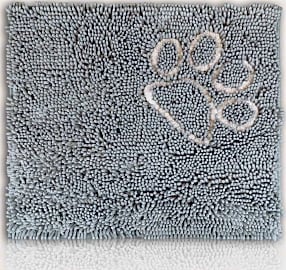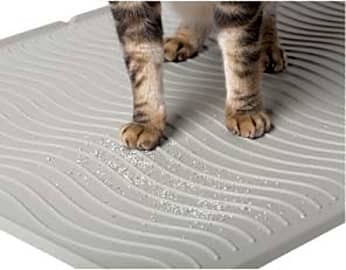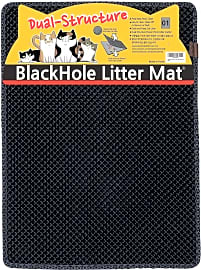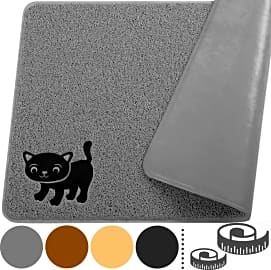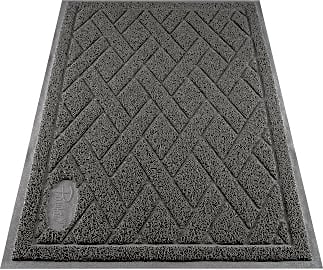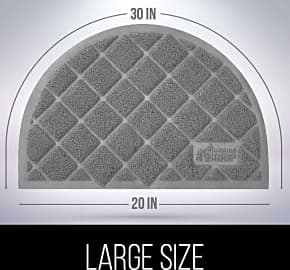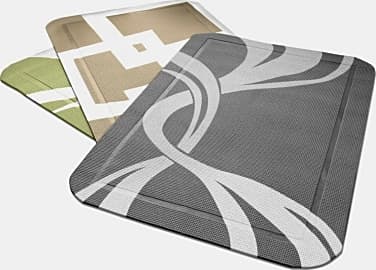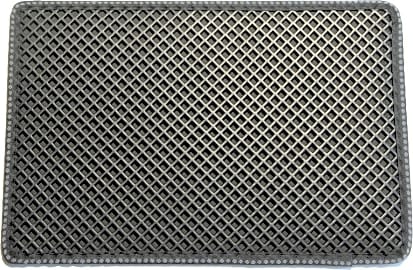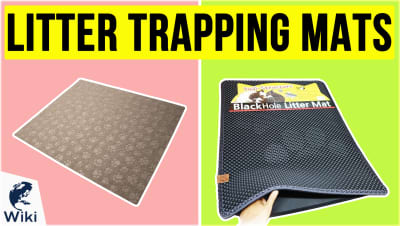The 10 Best Cat Litter Mats

This wiki has been updated 33 times since it was first published in January of 2017. We all love our cats, but we don't love the mess that a litter box creates. That's where these mats come in. They are specially designed to prevent kitty from tracking granules throughout the house and will help keep your home clean and sanitary. They come in a wide variety of shapes, sizes, and colors, making it easy to find the purr-fect solution (groan). When users buy our independently chosen editorial recommendations, we may earn commissions to help fund the Wiki.
Editor's Notes
September 26, 2019:
Cats are notoriously fickle creatures, which can make it tricky to choose the right mat. With that in mind, we put together a list that features items of varying sizes that are crafted out of a range of materials, such as PVC, silicone, rubber, and microfiber. All of our selections are made to be soft on paws, with the CatGuru Premium being extra plush.
Our latest update brought on the removal of the Drymate Surface Solutions, which we felt was not as compelling as the CatGuru model. We also cut the WooPet Scatter Control due to availability issues and swapped the Petmate Catcher for the higher-quality Gorilla Grip Scatter Control.
All of these units are designed to trap various types of litter and be extremely easy to clean and very durable. We also prioritized items with nonskid backings and layers that trapped liquids in case kitty feels the need to pee on it. After that, we looked at value for money and design, as many times a cat litter mat is visible to yourself and guests, and so should be neutral to blend in with different decors.
Choosing The Right Mat
Even if your cat uses non-tracking litter, she can still get little granules stuck between her toes.
Even if your cat uses non-tracking litter, she can still get little granules stuck between her toes. The easiest way to prevent this is to obtain a quality mat that will grab the sediment from her paws and keep it from being tracked across your floors and furniture. There are a few aspects to consider before you make your choice.
First and foremost, ensure that the product you're buying is the correct size. It's important not to skimp in this regard, as one that's too small will do little to prevent tracking. Hooded boxes need a mat that extends well across their entrance, with enough space to slide either partially or completely underneath. If you have an open tray, you'll have to place it on top of the mat and ensure there's ample room extending out from every side, since your cat may exit from any direction.
You’ll also want to confirm that the item you’re eyeing is compatible with the litter you use. Some are suited for pellets or corn granules, whereas others are adept at grabbing clay and crystals. If you’re still experimenting with different varieties of litter, opt for a universal option that’s constructed to trap everything.
When considering materials, you'll want to think about your cat's tactile preferences. Some kitties take to softer materials like fabric or foam, while others may be fond of stiffer plastic. From a cleaning standpoint, fabrics are generally machine washable while PVC and other plastics are easy to shake out or hose down.
The messiest cats will benefit from a multi-layered mat. The best ones are usually crafted from EVA foam that's waterproof, scratch-resistant, and soft on paws. Many use a grooved design to seize litter and release it into a bottom layer. These styles are also straightforward to clean — simply shake the litter out of the interior pocket and into the trash.
Ways To Combat Litter Box Odor
You might adore your cat, but it’s probably safe to say that you’re not fond of the stink they leave behind at the litter box. Below, we’ll go over a few tips to help you keep your home free of offensive odors.
Below, we’ll go over a few tips to help you keep your home free of offensive odors.
It’s important to make time to scoop your cat’s litter box at least every other day. This way, you'll prevent unpleasant smells from creeping into the far corners of your home. If you’re pressed for time or have more than one kitty, consider investing in a self-cleaning litter box instead. It’s also a good idea to replace the litter on a regular basis. This involves removing everything from the bin before washing it thoroughly with soap and warm water.
Of course, you can’t run in and tidy up after your cat every time she goes to the bathroom. You’ll need additional help to stay on top of those unsavory odors between cleanings. Deodorizers are an extremely easy way to do this; simply sprinkle a small amount over the litter after you scoop. It will release a continuous pleasant scent until it conveniently dissolves in liquid. There are non-toxic varieties available, but if your cat is older or sensitive to strong smells, try using baking soda. Not only is it an incredible neutralizer that absorbs odors fast, but it’s budget-friendly and sold at most grocery stores.
And while it’s tempting to hide the box somewhere dark, enclosed, and away from prying eyes, it’s really best not to. Seek out a well-ventilated area in your home that doesn’t see much foot traffic, such as the laundry room or garage. This way, those stinky aromas have a chance of dissipating instead of being focused in one location.
A Brief History Of The House Cat
Anyone who has a feline companion will tell you that you don’t own the cat — the cat owns you. Their personalities run the gamut, from cuddly and devoted to mischievous and aloof. Despite their heavily-followed Instagram accounts and newfound Youtube stardom, cats haven’t changed much over the years. In fact, they’re still remarkably similar to their wild cousins in respect to genetics and habits. Domesticated cats share around 95 percent of their DNA with tigers, and they’ve maintained the hunting skills necessary to survive when they’re abandoned by humans.
Researchers postulate that we lived alongside cats for thousands of years before they became our beloved house pets.
Researchers postulate that we lived alongside cats for thousands of years before they became our beloved house pets. They believe that, in typical cat fashion, our furry friends domesticated themselves after a certain point. By studying ancient remains, archeologists have found evidence that they most likely migrated from Asia and into Europe around 4400 B.C.E.
As humans began to settle near areas they could farm, they discovered that certain pests were quite fond of munching on their crops. It’s likely that cats approached ancient communities in order to pursue rodents, and in doing so they sparked the beginning of a symbiotic relationship. We were very grateful for this complimentary pest control, and it’s not hard to imagine that some people might have become attached to the kitties with the most amiable qualities. As wildcats grew more tolerant of their new human compatriots, they started producing tamer offspring.
Around 1500 B.C.E., a separate lineage of African felines spread into the Mediterranean. At this point, various cultures had already become truly devoted to them. Egyptians worshipped and mummified cats, and the punishment for killing one was death. Romans felt similarly, viewing them as a symbol of independence. The tides turned during the Middle Ages, as people began to equate them with black magic and witchcraft.
Their public image began improving again in the 1600s, and by the Victorian era, they were the objects of our affection once more. Queen Victoria herself had even adopted two of her own, and her subjects admired her so much that they quickly took to copying her. Countless authors also made a point to document their love of cats, including luminaries like Charles Dickens, John Keats, and Mark Twain. Their popularity soared from there, and these days they’re represented in comics, television, literature, and more.


